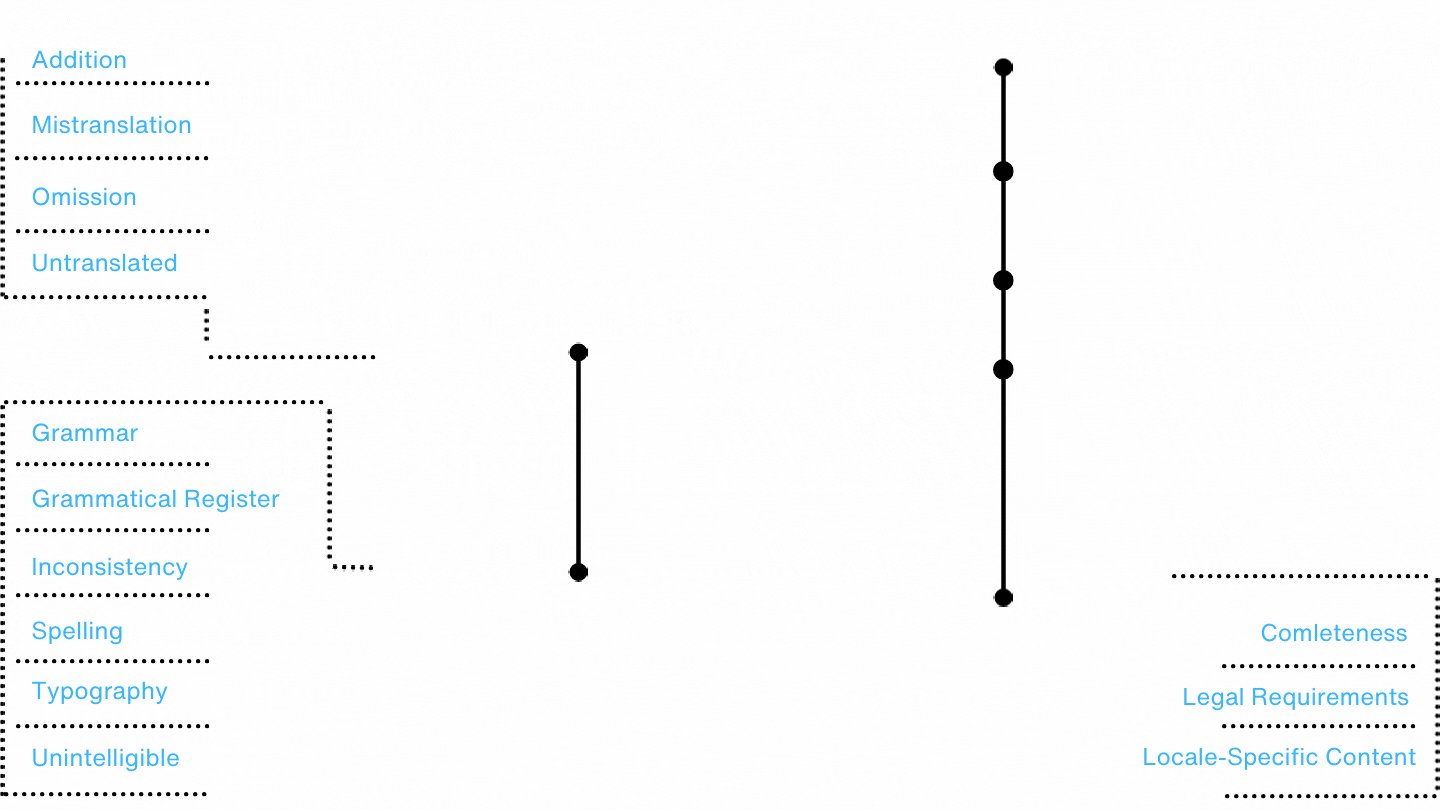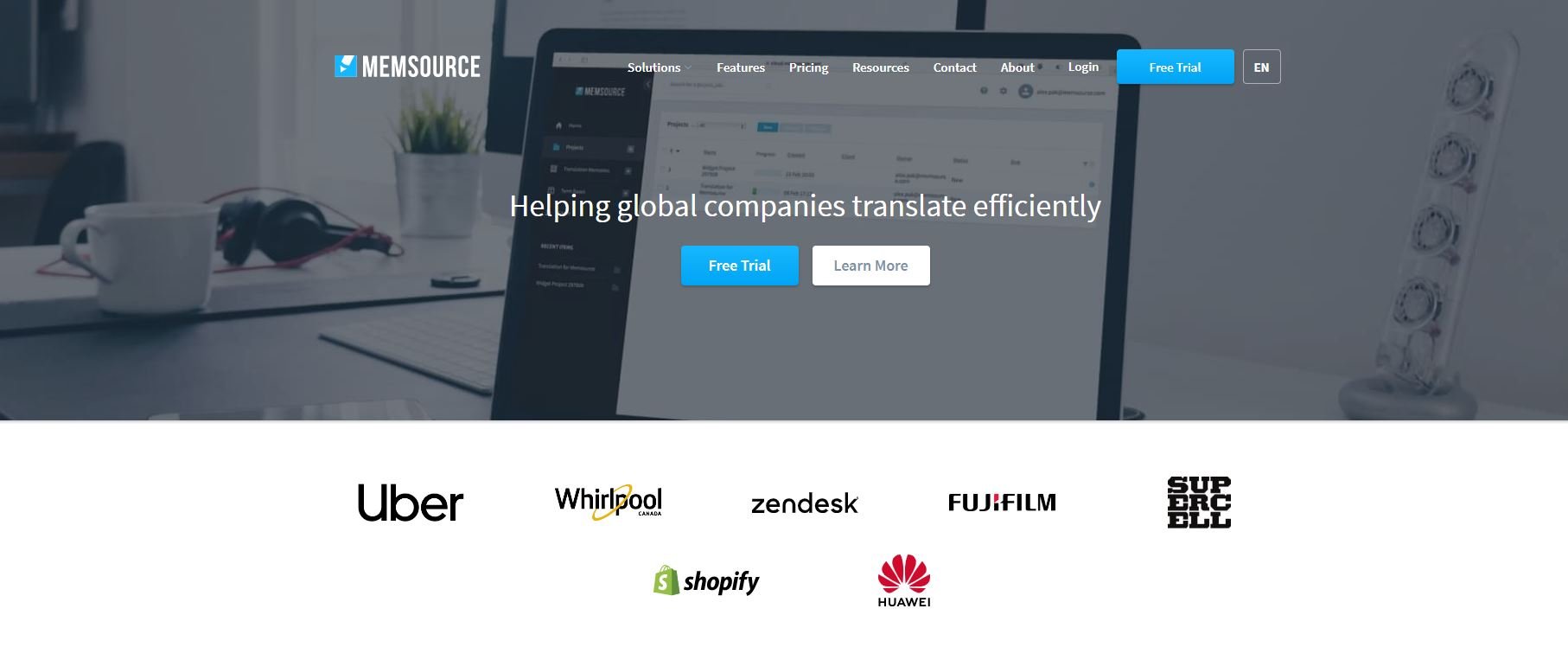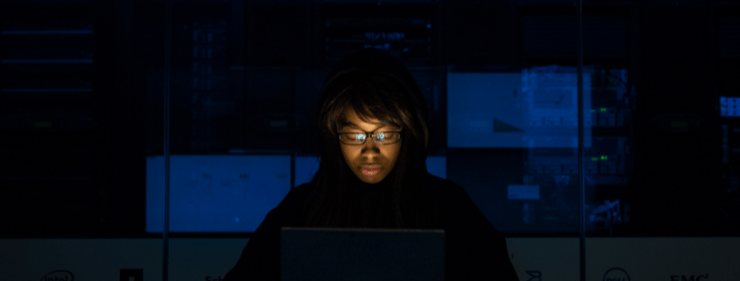Learn how QA through Multidimensional Quality Metrics (MQM) increases accuracy, fluency, speed, and cost savings for enterprise clients in translation for localization projects.
Table of Contents
2. What is Translation Quality Assurance?
3. How Does Translation QA Work?
4. What is MQM and How Does It Work?
5. How Do Translation QA and MQM Work in Memsource?
6. How Does Memsource LQA Work?
7. Learn How to Use MQM and LQA
8. Translation QA Metrics Use Cases
9. Quality Assurance Vs. Quality Control
10. QMS – QA and QC Working Together
11. Conclusion
12. Andovar, Why Work With Us?
1. Introduction to QA Through MQM
Quality Assurance through the application of Multidimensional Quality Metrics (MQM) increases accuracy, fluency, contextual quality, speed, and cost savings in enterprise translation for localization.
Andovar has implemented Multidimensional Quality Metrics (MQM) into our translation for localization workflows. We have integrated MQM technology with Memsource, the Translation Management System (TMS) Andovar uses. Here we’ll examine the practical uses of cutting-edge MQM strategies for QA in the context of various kinds of business content, such as marketing pieces, technical manuals, software user interfaces. The information below is to help you develop a general understanding of what the translation and localization Quality Assurance process incorporating the use of an MQM framework looks like and how it works.
Why are Multidimensional Quality Metrics in Translation QA Important?
To be a global company requires building the same level of trust in customer care that you’ve established with your audience in your native language. After all, using over 50 languages still doesn’t quite reach 100% of users on the World Wide Web, and according to the Harvard Business Review, over 56% of consumers say that when they’re considering buying a product, having information about it in their native language is more important to them than the price of a product!
So, to expand your international market reach and scale your business, you have to be effective in your outreach to speakers of Chinese, Japanese, Hindi, Spanish, and other major languages that account for large percentages of the global consumer marketplace. That’s why the language translation industry is projected to exceed US $56 billion this year (2021).
In the thriving global market, competitors need the best possible translation and localization of their marketing and branding. The outdated rudimentary translations of the past are now replaced by today’s state of the art in translation and localization technologies, processes, and techniques. Adding Multidimensional Quality Metrics tracking to the QA toolset is the natural next evolution of the combined MT and human localization modality for enterprise translation clients.
2. What is Translation Quality Assurance?
Language translation makes it possible to create a global enterprise. It makes universal communication possible. Naturally, this first fundamental of human engagement must be accurate, and much more, a translation must convey the intended impression on its receivers in other environments and cultures. This means:
- The content must be ideally geographically and culturally customized to communicate the sender’s experience of the content while enabling the recipient to process it through the filter of his or her own experience.
- Ultimately, in a successful translation, the information, attitude, and nuances contained in the communicated content are clear to the recipient.
- Further, the intended impression succeeds to the extent that the content is not just clearly understood and fully appreciated by the receiver, but achieves relatability to the extent that the sender and receiver are engaged in a fully shared experience.
That’s a complex endeavor. This is where Translation Quality Assurance comes in. Translation QA is the series of steps taken to make sure those things are achieved in the communicated content.
What’s the alternative to doing what it takes to produce such a high-quality translation? For any type of business or entertainment medium, failing to apply appropriate processes to achieve quality content translations can grossly undermine the effort to introduce a product, severely damage your brand, and devastate the financial outcome of the product launch. It’s a costly lesson that most thriving international sellers don’t need to learn twice.
Technologically speaking, Translation Quality Assurance is a comprehensive tool that automatically identifies errors as you are translating with translation management software (TMS). Translation QA is an essential integrated process for delivering ideally translated content in every project. The software is an integral module on the best TMS platforms. 
3. How Does Translation QA Work?
There is a whole range of QA metrics for measuring aspects of translation outcomes and distilling those quantifications into a picture of what translation quality looks like. Various translation companies have their own combinations of Quality metrics. So, the differences in what constitutes quality can, for various translating companies, be partly due to the differences in client types and their correspondingly different types of needs and expectations. What translation providers can agree on is that a high-quality translation meets at least some commonly established quality benchmarks.
But, what does reaching these translation assessment thresholds entail? Of course, different kinds of content require different levels of attention to translation and localization quality. For example:
- Scenario A: If an ordinary internal business document with tech department information needs to be translated into a different language. In this case, a human translator doesn’t need to be expert level. Or, a machine translation without post-editing will probably be sufficient.
- Scenario B: Localization of high-value marketing webpages for a product entering a fiercely competitive foreign market requires the best translation for localization process you can bring to the high-stakes rollout.
In both scenarios above, the translation quality meets the client’s expectations for their target audience. In Scenario A, accuracy is set as the metric of greatest importance. Alternatively, in Scenario B, while accuracy is a high priority, an even greater value is assigned to fluency and localization than accuracy.
So, quality can be said to be relative, in terms of meeting expectations. Nevertheless, Scenario B naturally requires much more in the conversion and QA processes to meet expectations.
Steps in the Translation QA Process
Even though we’ve roughly established that translation quality is arguably subjective and the metrics used for measuring quality vary between LSPs, they all follow a similar general QA process. Most translations for localization projects use a process that fits this basic outline:
- Planning: The client provides the LSP with a list of general requirements for the translation work. Project planners obtain, organize, schedule, and manage the human resources and tech tools necessary to meet those requirements.
- Translating: One or more translators who are native speakers of the target audience’s language, and who have sufficient depth of insights into their culture are assigned to the project, and the translation work is done.
- Editing: A human editor carefully examines the translated text. Like the translator(s), the translation editor is fully familiar with the subject. The editor meticulously checks for various types of errors and flaws and ensures that the intended meaning is correctly conveyed.
- Formatting: A desktop publishing team, web design team, video/audio post-production team, or multimedia team formats the translated text or recorded audio content to blend with the medium in which the content will be presented in print or on screen to the target audience.
- Proofing: A final Quality Control check is conducted to ensure that no elements intended for translation are missing and the finished work meets expectations. The project manager is informed of any issues and remedial processes are done to perfect the final product.
- PM Review: The project manager personally reviews the finished product, then sends the final version of the translated and localized content to the client.
- Client Review: The final Quality Assurance step in the project is the client’s review. The client provides feedback, requests improvements, as needed, or approves the localized content.
The translation Quality Assurance process, of course, entails multifarious substeps within each of the above-listed primary steps. As you can see, altogether, the outline indicates a rigorous total QA process that pervades all phases of the project in the QA mission to produce error-free localized content that satisfies the client’s needs and expectations.
Contributors to Translation QA
- Machine Aids: Including management of translation memory and terminology
- Human Editors: To proofread and edit translations and ensure the desired message tone for the target audience is achieved
- Translators: With well developed knowledge of the regional, national, and local environment, political atmospherics, and the traditional and modern subcultures of the target area
The Client's Role in Translation Quality
Our enterprise translation clients have a key role in ensuring optimum translation quality. To maximize the quality of localization project outcomes in the minimum possible time frame, clients should provide:
- All possible contextual information.
- The clearest source text possible.
- A company style guide for marketing and branding content.
- A glossary of company and industry terms and phrases.
- Communications availability for questions and collaboration with translators.
The Old Methods of Translation Services Aren’t Good Enough.
Typical translation system models don't work for enterprise localization clients. The inefficient, excessively time-intensive manual processes and lack of transparency do not compare well to the new generation of translation services. Arguably, a great beauty of today’s advanced QA processes is that the new technologies fit into pre-existing website and broadcast media content development processes. But, they deliver so much more, including:
- Many multiples of translation output volume
- Enriched translation context
- More productive human interactions
- Consolidated workflows
- Far greater accuracy rates in translations
- Deeper resonance with international audiences
To accomplish these elevated quality objectives, three translation services are applied:
- Professional translation: Human translation changing the content word for word.
- Transcreation: Translating the meaning, style, and tone of your content.
- Post-editing: Mixing AI-enhanced MT with human editing for accuracy, tone, and brand voice.
Additional services are based on goals for the content and the content type. For example, your project may require specialized translations, subtitles, transcription, voiceover, linguistic assets development, international SEO, and supplementary MTQA, optional QA spot checking, or other added QA processes.

4. What is MQM and How Does It Work?
Multidimensional Quality Metrics is a framework for the assessment of language translation quality that enables translation project managers to customize their own system of quality metrics. MQM for translation evaluation is a translation management technology innovation developed by the European Union’s QTLaunchPad project.
The MQM software provides a single quality metrics system applicable to both human and machine translations. The MQM system is further designed to upgrade the process of estimating the quality of automatic translations.
Benefits of Adopting the QA-Through-MQM Model
To reach a foreign market with your message, you’ll need to work with an agency with translators who are experienced not only in translating but in localizing translated content. The translation should have professional editors lavishing the amount of attention necessary to get it right, not just for speakers of the target language, but for consumers immersed in the geographic, social, political, and cultural traditions of their local areas of the target market. This is a highly complex proposition.
It requires exceptionally proficient translation editors who are also fully familiar with the experience of the locals in the target market locale. For enterprise businesses that are pursuing rapid global scaling, these efforts must be multiplied, sped up, i.e., scaled commensurately with the desired pace of growth.
But, how to do that? Hire a mass army of translators and localization experts? Fortunately, there’s a better, more efficient, more consistent, and more cost-effective way.
Today’s top LSPs can meet the expectations of clients, who need accuracy, fluency, and quality localization in translations, with state-of-the-art QA processes featuring world-class human translators, AI-enhanced MT, revolutionary MQM technology, and expert localization editors. Combining these enterprise-level localization resources delivers the benefits of elevated media content:
- Expert editing: Attention to fine details produces translated messages that convey complete, clear, and easily digestible communications with your target audience and help establish your brand as one offering a reliable customer experience.
- Customized localization: Delivers content that meets your specific needs for your particular industry and content type(s), needed to overcome typical obstacles to penetrating new markets.
- Wide integration: Works with a wide range of highly relevant platforms, which puts you in full control of all your content for localization from any source or format. QA metrics selection and scoring tools are intuitive for users and compatible with virtually any text source file format.
- Rapid processing: Speeds up the translation and localization process to an extraordinary rate, enabling your company to offer exceptional responsiveness to translation requests. Some translations and quality reviews can be completed in just minutes for priority turnaround, for example, in customer communications.
- NMT and Human Review: Combining cutting-edge Neural Machine Translation, revolutionary Multidimensional Quality Metrics QA technology, and expert localization editors provides your customers with the world’s clearest and most relatable marketing content, product sales descriptions, and customer support communications in their native language, to optimize customer experience and your potential ROI for a fraction of the cost of much lower-quality conventional translation processes!
Using Multidimensional Quality Metrics
How is MQM used to develop metrics that measure the quality of different methods of translation? First, let’s drill down to the core of MQM. The MQM framework contains these qualitative dimensions:
- Accuracy: Consistent meaning between source content and translated content
- Fluency: Linguistically well-formed translated content (grammar, consistency)
- Terminology: Using words to relate to concepts not used in non-industry-specific language
- Locale Convention: Conformance with target locale conventions, such as currency formats
- Style: Both formal, as stipulated in style guides, and informal, such as a “conversational” style
- Verity: Suitability of the translated content for the target market environment
- Design: The layout, format, and other presentational elements of the translated version
- Internationalization: Engineering of source content to enable translation/localization processing
Users of the MQM system of QA aspect quantification can determine appropriate dimensions for a project based on the nature of the project and the requirements for execution. After the applicable dimensions have been identified, the user can then choose types of issues. MQM has cataloged over 100 types of issues along with definitions as well as examples of each.
MQM also contains a set of fewer issue types applicable for most translation purposes. This is known as the “MQM Core.” The MQM Core and the many ways it can be used may be better understood this way:

How to Assess Translation Quality using MQM
The MQM framework offers a versatile method of developing QA metrics to fit various types of translations and match them to the user’s set expectations. MQM draws from a base of more than 180 types of translation issues. The technology supports varying degrees of granularity and adapts to match the requirements of virtually any quality assessment specifications for translation QA. In the MQM software application, you can define your own metric, by applying the various Quality dimensions you selected for customizing your multidimensional system of Quality Metrics.
The MQM process starts with developing your desired specifications and continuing through Tasks 1-8, as described in the table below. A single metric you may choose to define for your translation project could be, for example, the results for Tasks 1–5. The metrics you select can be kept in a library for future use in similar translation projects. This table outlines the process flow for selecting and utilizing the metrics in your larger QA process.
MQM Metrics Development Tasks
Task |
Action |
TASK 1 |
Enter Specifications: Define clear expectations for the translation. Judge quality based on defined expectations. Problems in outcomes indicate a need for improved specificity in the definitions of the expectations. Specs are from 21 “parameters” that cover all facets of the translation project and outcome.
|
TASK 2 |
Choose Dimensions: MQM dimensions for selection include those listed and defined above in the section Using Multidimensional Quality Metrics.
|
TASK 3 |
Choose Method(s): Choose a method of assessment for each dimension selected. Method options include, for example, Analytic, which identifies the specified errors. Methods selected should help reduce human efforts.
|
TASK 4 |
Select Problems: Select at least one issue for each dimension. For instance, select to measure Fluency, which can include checks of grammar, spelling, etc. Problems that are not priorities should not be chosen for checking. For example, you might not select Style for basic internal procedural documents.
|
|
TASK 5
|
Set Problem Weights: Assigning weight values establishes the relative level of importance of the various types of issues for purposes of the analytic analysis of the quality metrics. For example, Style may be given a larger weight value than Terminology in the quality scores to be generated by the MQM system.
|
|
TASK 6
|
Decide Thresholds: Thresholds establish the requirements for an acceptable translation. In the analyses, these are values based on the ratio of the weight value of the errors to the total words in the content. Thresholds can be determined for whole dimensions or single issues.
|
|
TASK 7
|
Start Workflow: The selected MQM metrics — each of which consists of a combination of methods, dimensions, issues, assigned weights, and set thresholds — are processed in an appropriate workflow with accompanying assessment tools. The translation workflow process for assessment is designed to produce objective outcomes and decisions for the user, such as: Approve the content. Or: Send the source text back to the translator.
|
5. How Do Translation QA and MQM Work in Memsource?
Memsource is the world’s top Translation Management System, ranked as the world’s most viable TMS by CSA Research (2019). This state-of-the-art translation management technology supports over 500 languages, more than 30 machine translation engines, and over 50 file format types.
The revolutionary Memsource platform makes it possible to increase language translation quality measurably while reducing project costs. Memsource’s patented cutting-edge AI technology serves thousands of global companies, including Zendesk, Uber, Vistaprint, and many others.
Automated Translation Quality Assurance consists of parallel reviews. An automatic QC system works to identify errors in the text during translation, while the Memsource Linguistic Quality Assurance (LQA) process works to classify the errors and generate statistics for error metrics, to provide organized feedback for translators.
6. How Does Memsource LQA Work?
Memsource has launched its comprehensive Language Quality Assessment (LQA) features this year (2021). The powerful AI-facilitated Memsource TMS has rolled out its LQA human review QA component for monitoring translation errors and scrutinizing overall translation quality. The new LQA features include:
- Profiles that can be customized to assign value to the levels of importance of identified error types and to enable thresholds for simple pass/fail scores, if preferred.
- Rules and weight assignments set by users, for errors based on content types, style guides, etc. For instance, marketing texts might be assigned a lower weight for accuracy errors than tech specification texts.
TAUS has developed its Dynamic Quality Framework (DQF). Together with the Multidimensional Quality Metrics (MQM) error identification and type scoring model developed by the EU, the two initiatives have laid the foundation for further innovations in methods for QA assessment of language translations. The EU’s leadership toward universal standardization is especially encouraging wide adoption and further advancement of the ground-breaking DQF-MQM model.
The framework for terminology testing in the DQF-MQM determines what constitutes a measurable error, of course. Errors can be defined using customized weighting. Their identification in the comprehensive QA assessment process includes failure to meet specifications under each of the MQM core qualitative dimensions listed above, among satisfying other definitive criteria set for error recognition in the system.
In the process, a quality reviewer completes the LQA piece of the process, after which a QA score is calculated in the system. The score factors the identified errors, their assigned weights and severity levels, and the total content word count. The LQA profile design features the configuration of a perspectival pass/fail threshold to shape the assessment outcome.
The detailed QA scorecard is delivered within the project workflow, enabling stakeholders to make real-time evaluations and determinations on the degree to which a translation meets or fails to meet the set standards. The downloadable MQM scorecard displays a complete assessment overview, including the particulars of the corrected version of the translated content. QA editors or project leaders can share the feedback, or translators can download the scorecards themselves.
Sample MQM Scorecard
This state-of-the-art Memsource LQA process now provides a process that is exceptionally conducive to collaboration between translators and QA reviewers. Reviewers have the ideal tools for adding descriptions and other notations to specific issues in their LQA assessments. The fully transparent system makes the added notes visible to translators in the Memsource Editor module and enables them to add their responses in the same thread that the QA reviewer uses.
Memsource’s comprehensive DQF-MQM translation QA solution now allows localization clients to customize the LQA process with their own granular specifications and style guides. These advanced QA review and engagement features are designed to optimize evaluative methods in language translation QA processes and enable reviewers and translators to operate on a new level of mutual transparency and collaborative effectiveness.
7. Learn How to Use MQM and LQA
The range of web content a company publishes must grow in order to reach new international audiences, and all those new content types require the highest possible quality of localization.
All major online competitors are well aware that each translation and localization enables their access to a new region of the global market. However, limited budgets for marketing translation make it imperative to choose carefully which languages, countries, and local markets to target.
Still, the dream of the most ambitious globally aspiring enterprises is to operate in all possible international markets at once. Yet, currently, language conversions are performed through rudimentary processes using public machine translation engines across multiple divisions of any given business. In most cases, employees are struggling with tedious, time-intensive, manual word-by-word processes. These comparatively costly methods typically produce only syntactically-disconnected rudimentary communications.
So, it makes sense to insist on progress in this area of global business operations. The Memsource LQA system marks an advancement beyond the laborious and ineffective step-by-step translation processes. The future of global business outreach calls for a much more richly integrated, data-driven localization approach that is systemically integrated for higher accuracy and overall efficiency.
What do MQM and LQA mean for localization of product descriptions and online e-retail content?
An AI-facilitated LQA platform can allow you to create digital and other media content in multiple languages with incomparable efficiency. This means you can access new target markets with multilingual ad campaigns, generate international sales, build your brand, and establish a loyal global customer base much more rapidly than was ever possible before the advent of the LQA technology.
8. Translation QA Metrics Use Case
Here is a strong example of enterprise-level application of the principles of QA management using MQM and realization of the associated benefits of MQM adoption:
Netflix MQM Utilization
The Netflix team charged with globalization processes the gamut of content types, from TV descriptions to broader marketing campaigns, to legal documents. The streaming media giant has implemented a Multidimensional Quality Metrics (MQM)-driven QA auditing system, to measure quality along these vertical marketing tracks. The objective of the MQM implementation is to identify deficiencies in their various content types and establish goals for quality improvement across the organization.
Although MQM is an exceptionally flexible technology, implementation for application across a large organization is a complex endeavor. But, Netflix has successfully worked through the process and developed a diverse set of quality performance metrics that is easy for users to understand and act on.
Netflix QA leadership can now more efficiently and insightfully manage expectations of quality. Their MQM QA management process extends across their global marketing, social platforms, studio production, and media product management teams, who all work at a continuously high pace. The MQM resource is further extended to QA in managing expectations of their system’s end-users — their media customers.
9. Quality Assurance Vs. Quality Control
The roles of Quality Assurance and Quality Control in language translation are both aimed at producing a quality outcome, but the concepts QA and QC are not the same. To help ensure you’re getting the maximum value from your localization project, it’s important to know the difference:
- QA: QA involves devising systems and creating guidelines for managing the production process in a way that ensures quality. The primary purpose of QA is to prevent errors and defects during production and minimize the risk of financial loss from the need to correct or discard a poor-quality product.
- QC: QC involves inspecting the final product, checking, or testing the product to confirm that it meets the standards set for acceptable quality for delivery. The primary purpose of QC is to identify errors and defects after production is completed and take corrective action to bring the final product quality up to an acceptable level or discard an unusably poor quality product.
10. QMS – QA and QC Working Together
Fundamentally, a Quality Management System, as defined by the ISO, includes all the familiar primary components of a top managerial role:
- Planning
- Creating and overseeing the implementation of improvement initiatives
- Establishing policies
- Setting objectives that serve as guidelines for an organization
As those guidelines apply to QA and QC processes, the general guiding principles for QM can be understood as:
- Quality Management leadership
- Focus on customers’ success
- Relationship management
- Evidence-based decision-making
- Use of the Process Approach
- Valuing improvement
- Stakeholder engagement
For thorough detailing of each of these core QM principles as identified by the ISO, see the ISO publication Quality Management Principles.
11. Conclusion
Revolutionary MQM QA technology, along with cutting-edge NMT integrated into today’s powerful translation management platforms like the Memsource TMS and expert human editors have made traditional means of enterprise-volume translation for localization obsolete. Global companies localizing for multiple markets should obtain thorough information about QA/QC processes in place at LSPs you’re considering for volume translation projects.
Translators should be native speakers of target languages, experienced in localization, and fully familiar with the physical environment of a foreign locale and all aspects of the culture of the target market there. The translation should have highly proficient professional editors lavishing the amount of attention on it necessary to get it right. No matter how much QA technology is applied, LSPs are unable to meet client expectations without talented localization professionals involved.
When embarking on a localization project, you should determine your specific needs and whether the features and benefits of the QA-through-MQM model make this option the best fit for your project. Consider the scope of your project, your present options, and any obstacles you have been encountering in your efforts to penetrate new international markets.
Quality is critical, but it can’t take forever. Scaling globally requires optimum efficiency in support operations, including external translation and localization appendages you must depend on to make your brand voice heard, market and sell your products, provide customer support, and build relationships that will sustain a global business.
The most successful global competitors are sure to be taking full advantage of the international resources at their disposal and to increase their advantages through expeditious management of processes. This, of course, includes content translation and localization. So, how soon high-quality converted content can be produced is a natural priority for today’s enterprise LSP clients.
Ultimately, the most efficient production of the best quality in localized content is the winning formula for LSP selection. Look for providers that feature the best in integrated translation and QA technologies, that enable consistently rapid high-quality production in response to your business’s ever-growing and changing translation needs.
The optimal LSP teams include exceptional post-editors and the advanced technologies needed for the most efficient translation service for enterprise clients. The most overall effective prove to be those that currently combine AI-driven NMT with a QA-through-MQM model, such as Memsources LQA adaptation.
This production and Quality Management formula offers today’s most reliable approach to rapid provisioning of content for continuous supply to international markets. That means it’s also the best available option for maximizing potential ROI at a fraction of traditional translation and localization costs!/you-paid-how-much-cover-1-1.jpg?width=740&name=you-paid-how-much-cover-1-1.jpg)
12. Andovar, Why Work With Us?
We are a global provider of enterprise translation services and content localization for digital and other media. We help enterprise companies, games developers, eLearning, HR & training, marketing, entertainment media, software developers, e-commerce, and other types of organizations produce global content localized for their international audiences. Our mission is to provide solutions for complex localization projects to facilitate our client companies’ seamless international growth.
Our QA system applies MQM in a wide variety of content localization projects, such as multi-media marketing campaigns, SEO web content, customer support, technical documentation, product descriptions, promotional materials, and more.
Andovar has helped some of the world’s largest global e-retail brands for more than 20 years. We localize vast volumes of content for some of our clients. With our team of over 3,000 translators and more than 100 engineers and project management staff, we make global scalability possible at a lower cost.
Our services include turnkey localization, localization engineering, text and voice localization (subtitling and dubbing), integration, and testing. Our global headquarters is in Singapore, and we have production service locations in India, China, Thailand, Hungary, the U.S., and Colombia.
For more tips and content on global growth, please visit our blog.














